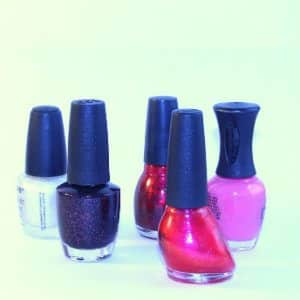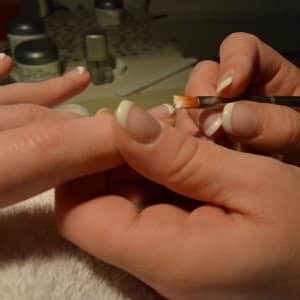
This growth in business, however, is not translating to better working conditions for the employees who help others relax and feel better. In fact, as a two-part investigative series in the New York times showed, these workers are typically underpaid, overworked, and exposed to serious hazards that not only impact their bodies but can also lead to problems with their future children.
The Investigation
The New York Times isn’t the first organization to realize that nail salon employees are suffering. More than a decade ago, a group called the Asian Health Services noticed that there was an extremely high number of health complaints among nail salon workers, who, in that area, are mostly Vietnamese. An independent investigation was performed and the conditions they saw were so terrible that they tried to get lawmakers to enforce a ban on certain chemicals but the industry was able to block the movement.
I Paint My Nails At Home – Should I Be Concerned?
There are chemicals found in nearly every product used in a nail salon. These products can find their way into the body through:
- Breathing: Dust, mist, and vapors can all be inhaled into the lungs. From there, the chemicals can be absorbed into the lining of the lungs and eventually make their way into the bloodstream.
- Skin Contact: The skin is permeable and if a product comes in contact with skin or eyes, it is possible that it could end up being absorbed into the body.
- Ingestion: While most workers don’t pick up a product and drink or eat it, if foods or drinks are not kept in sealed and covered containers, it is possible to swallow them without even knowing it.
The most common hazardous chemicals that nail salon employees come into contact with on a daily basis include:
- Butyl acetate: Found in nail polish, this can cause headaches and irritation in the nose, mouth, and throat.
- Acetonitrile: This is part of glue remover and exposure can result in nausea, vomiting, issues with breathing, and weakness.
- Ethyl Methacrylate (EMA): Found in nail polish, it can cause skin, mouth, nose, and eye irritation. It has also been reported that exposure may result in health conditions in unborn children.
- Methyl Methacrylate (MMA): Found in numerous products used in nail salons, this can cause asthma, a loss of smell, and difficulty concentrating.
- Toluene: Used in nail polish and glue, this chemical can result in headaches, irritation in the throat and lungs, damage to the liver, damage to the kidneys, and health issues in unborn children.
Occasional quick exposure to these chemicals shouldn’t result in long-term issues, however, when exposure happens every day, serious illnesses can occur.
Aren’t There Rules Protecting Workers?
Yes. In the past, the Occupational Safety & Health Administration has created a set of rules and recommendations so that employers know how they can help keep their employees safe. These recommendations include:
Protecting The Respiratory System
The National Institute for Occupational Safety & Health has created filtering respirators that will help to protect the wearer from inhaling dust, vapors, and, in some models, chemical gases.
Avoid Contact With Skin & Eyes
Gloves and protective glasses can help prevent contact with hazardous chemicals and should be made available to all employees at all times.
Open Windows And Install Ventilation
Weather permitting, windows should be opened to allow fresh air to flow through the facility. Regardless of whether or not windows are open, proper ventilation units should be installed and on during working hours.
The problem is that just because the rules exist doesn’t mean that employers follow them.
What The NY Times Found
Reporters from the Times were shocked at the conditions nail salon workers experienced. The majority of these workers are Asian and Hispanic women and are frequently immigrants. When interviewed, these women revealed that often they worked for months WITHOUT pay until the employer determined that they had learned the skills needed. Then, if they were lucky, they made about $30 a day. Those who weren’t lucky were paid as little as $1.50 an hour.
A few women reported that when they arrived in the country, they had to pay the employer in order to get the job in the first place – typically about $100. New employees are told they have no other options and that because they are immigrant workers, they are not regular employees who could receive benefits, overtime pay, or workers’ compensation if they become ill. On top of this, because many of them are working without a license, they are reluctant to come forward and report their employer because they fear they will be punished.
Most work 10 -12 hour days and are constantly monitored by their employer, unable to even get a drink of water without first getting permission. Of course, typically if the employer is unconcerned about even paying their employees, they don’t follow OSHA’s safety regulations.
If an OSHA inspector does come to the shop, the employer simply tells the unlicensed girls to leave out a back door. They then falsify any reports they make to the inspector about the number of employees they do have.
What Is Being Done To Stop The Cycle?
In response to the deplorable conditions described by Time’s reporters in 2015, Governor Cuomo created a new multi-task force which would:
- do random spot inspections of all salons in New York
- create new safety standards which would help to protect workers from the hazardous chemicals they work with
- create a six-language program intended to spread the word to all nail salon employees about what their rights really are. Shops are required to have signs in their establishment informing employees that it is illegal for their employer to not pay them and letting them know what the minimum wages is.
Any salon that fails to pay their employees, doesn’t get their employees licensed, or that doesn’t follow safety standards will be shut down. Salons are now also required to be bonded so that if it is found they have not paid their employees, there is a way to obtain the money to compensate those employees for back pay.
Since its creation, the Nail Salon Industry Enforcement Task Force has helped thousands of salon workers and has ordered employers to pay more than $4 million in back pay.
The State Health Department also did research into how salons could be safer for workers and not long after the initial steps were taken, the Governor also announced that new ventilation requirements will go into effect on October 3, 2016. New facilities will need to have the new system installed immediately. Older establishments will have five years to update their building and meet the safety standard.
Can Sick Or Injured Employees Get Help?
Yes! Employees – even those that are not injured or ill – have the right to contact OSHA if they feel that their work environment isn’t safe. The employee may:
- request that an OSHA representative inspect their workplace
- have tests done that measure the level of potential exposure to hazardous materials in their workplace and receive copies of the results
- obtain copies of work-related illnesses and injuries
Workers don’t have to fear retaliation from their employer, OSHA never reveals the name of the employee who made a report.
Those that are already injured have the right to file a workers compensation claim. These claims compensate the employee for medical expenses and lost wages. Employers are required by law to have this insurance and if they say they don’t, the employee should contact an attorney as soon as possible to learn about their legal options.


